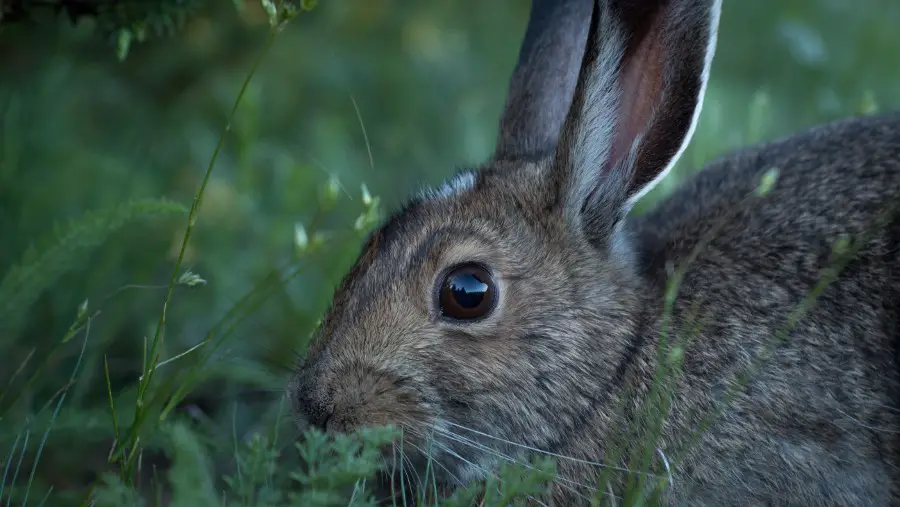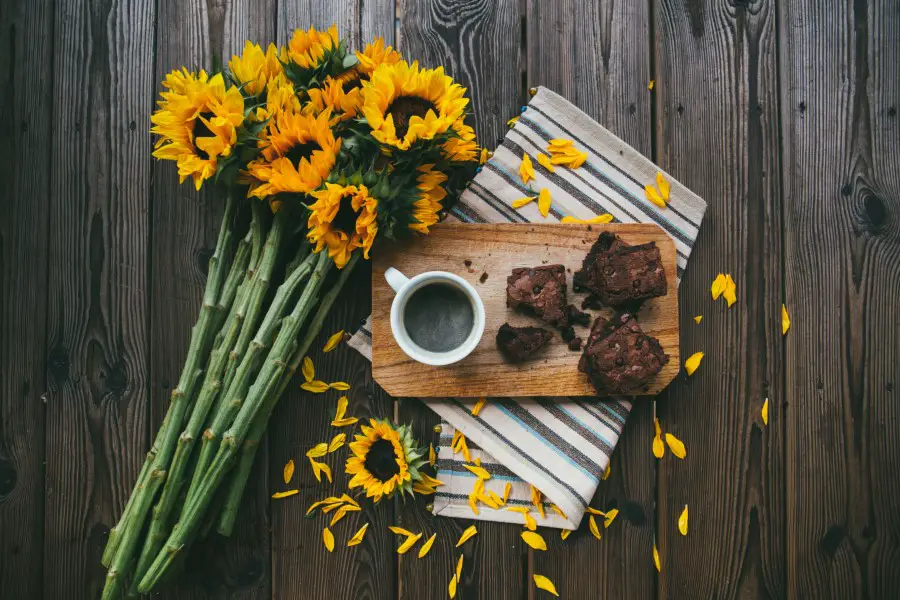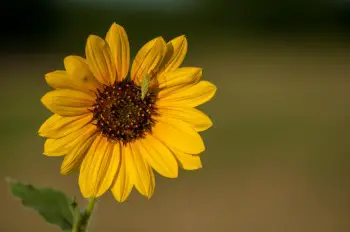Having grown sunflowers for many years I have had many a plant captured by critters before its prime. I am of course talking about bugs, beetles, birds and all manor of wild animals. They are attractive to a trove of wildlife. And why not, sunflowers are truly magnificent and yummy to many creatures.
So, what animals and bugs are attracted to Sunflowers? A numerous amount. Sunflower bugs and beetles, Cutworms, ladybugs, spiders, bees, snails, butterflies, moths, aphids, seed Weevils, squirrels, rabbits, birds, deer, mice, rats, hedgehogs, chipmunks, Raccoons and the list goes on. Many are good and beneficial, some bad. Let’s explore these further.
Not only are sunflower plants and seeds a tasty treat for me and my pets, I share them with the wild life that visits my garden too. Here’s some important information on Are Sunflower Seeds Safe for Your Pets.
Some my recoil at that fact, but I grow sunflowers for many reasons. The whole plant is a treasure chest of goodies for me and the environment.
For all my decades growing sunflowers I have taken this for granted, so I thought I could share and explore what bugs and wild creatures can benefit from our glorious, bountiful blooms too.
So let us gaze, and graze, upon the life of a sunflower in the eyes of our fellow creatures.
Home Grown Sunflowers
Luckily you don’t need a garden to grow sunflowers. A pot on your patio, decking or balcony will be sufficient, and the you’re on your way.
You’ve planted your seeds (the ones you’ve saved before anything else can eat them) placed the pot in as sunnier place as you can, and your seedlings are starting to grow. Please click here for my ultimate guide to growing Sunflowers
It won’t take long for your seedling to become recognisable as a sunflower plant. Sunflowers are one of the fasted growing plants, so make sure it’s well watered and the pot doesn’t dry out.
If you have enough pots, or garden, try growing different varieties and more varieties of bees will visit them and love you for it too. See my Ultimate Guide to Sunflower Varieties
What Bugs Are Attracted to Sunflowers
A picnic for wildlife and a safe haven for their young!
Before our sunflower has fully grown, and whilst it is a young plant, there will be a number of beetles and bugs visiting. Butterflies that will lay their eggs, leaf cutting solitary bees will take the greenery to build nests. Spiders will spin their webs and caterpillars will happily munch away too.
Ladybirds, ladybugs and lightning bugs will feast on the crowds of aphids. There’s plenty to go round and enough for all.

The List of Bugs That Visit Sunflowers
Depending on your location and region that you live in, here is a list of some of the bugs, beetles and invertebrates that may visit and enjoy our sunflowers as much as we do, for one reason or another.
- Lady Bugs
- Bees
- Leafhoppers
- Glassy winged sharpshooters
- Lady birds
- Butterflies
- Caterpillars
- Head clipper
- Weevil
- Black flies
- Moths
- Snails
- Seed weevil
- Aphids
- Flies
- Slugs
- Spiders
- Wasps
- Leaf cutters.
Blooming Lovely
As our sunflower Follows the Sun to maturity, a curious procedure called heliotropism, I wrote about what heliotropism is and how it happens. It grows strong and comes into its glory as a huge, golden (well usually) inviting bloom, and this is when even more action from the wildlife world will occur.
The beatles and bugs are still carrying out their daily duties but along come the pollinators. Bees and butterflies fill up on tasty nectar from over a thousand filled florets, in return for this tasty drink they pollinate our sunflower so it can produce seeds. Find out here How Sunflowers Pollinate.
To Harvest or Not to Harvest
Firstly, if your sunflower doesn’t appear to have any seeds, then click here to find out why
At the harvesting stage, the Larger variety of Sunflower can produce up and over of two thousand seeds and even at this stage the beetles and bugs are still foraging around, it is still a source of food and shelter to them.
But now bigger critters join the action and this is when you need to decide whether to protect all sunflower plants for your own pleasure and pets, ‘go halves’ with nature, by protecting some of them, or just let mother nature enjoy all of them till the end of the season.
To decide Lets explore our choices further…
What Wild Animals Eats Sunflower Plants and Seeds?
Depending on your location and region where you live. There is an action packed operation for the jewels in the crown of your sunflowers. An abundance of wildlife that will enjoy chomping on your plants.
These could include…
- A large variety of birds, Bats, Mice, Deer
- Squirrels, Groundhogs, Hedgehogs and Rats
- Chipmunks, Voles, Raccoons, Rabbits
To leave your hard grown sunflowers for Mother nature to enjoy I feel is a credit to you.

After the Seeds Have Gone
Now we have harvested our sunflower seeds or let nature have its way, our sunflower plant still has many uses and a lot to offer.
For our gardens, The cast off shells can be used for mulch and so to the stems. Or the stems can be dried out and used to build animal hides or winter homes for insects to shelter in.
For our homes, the seeds are not the only part of the sunflower we can eat, fresh, roasted or dried. The seedlings and leaves can be used in salads, the stalk is a crunchy celery like snack too. The seeds can be compressed for oil or processed for spreads and dips.
Some varieties of sunflowers shells can be used to make natural vibrant purple dyes for paints, soaps and their petals used as decoration. These are just some of the uses for sunflowers. I have plenty More Ideas for Sunflowers here.

My Tips and Advice
Again If you leave sunflowers to give back to the environment I commend you. I always plant more flowers than I need, even knowing that some of my seedlings might be a midnight snack for snails. I love watching the bees and butterflies feeding and flitting.
I can’t get enough of the funny antics of the squirrels precariously dangling upside down trying to wrestle the seeds from their cases, I take great pleasure watching the early morning birds pecking and feasting on a fresh delight.
The smaller unwanted seeds fall to the ground and are picked up for a midnight supper for the stealthiest of mice.
So I only harvest enough seeds for myself and my pets to enjoy, mainly for the nutritional benefits, and a bag of carefully stored seeds for the following years planting. As for the rest, I let the wild life enjoy my bountiful sunflowers to do with what they will.
How to Protect Sunflowers from Insects
Protecting Sunflower Seedlings.
Try using natural deterrents on your succulent seedlings. These could include crushed up egg shells and rough gravel piled up around your young plants.
If a huge outbreak of aphids or black fly occur try mixing a very mild solution of dishwasher liquid with water ( half a teaspoon of liquid to a pint of water) in a sprayer to spray on only the affected area. Though Usually these infestations will naturally clear up on their own and ladybugs will tackle them too.
Using shop bought poisons and pellets will in turn poison birds and animals that eat the slugs and bugs that you’re using them for.
Protecting Mature Sunflowers
When your seedling has matured into fully grown sunflowers that attract our list of bigger critters, and you want to deter them from scaling your beautiful blooms, try contructing frames for fruit netting, use mesh or chicken wire. While protecting from larger animals, it will still allow pollinators in to feast and get your sunflower to produce seeds.
To detract birds and wildlife further, try hanging feeders for them elsewhere in your garden. The wild life will soon get used to and learn quickly where there is an easier food source to be munched on.
After thoughts.
I wrote this because I get frequently asked. ‘What wild animals and bugs are eating my Sunflowers?’ a lot of these people actually refer to all of these as ‘pests’, but some of these ‘pests’ are an essential part of our environment. This cycle allows our world to develop naturally
I realise a lot of my own thoughts and feelings have gone into this write up, and I hope I have given you a glimpse of the view on my side of the fence. The sort of wild side.
Our Sunflowers are a seasonally glorious plant that are many things to many beings. I hope to think we can all enjoy them
To Conclude
Not only are they a tasty snack for us, and our pets, the sunflower and her seeds are an abundance of wealth to our environment and wildlife.
I love this in sunflowers, they are a complete package. The anticipation of hoping my saved seeds will poke through the soil. That the seedlings will survive being bug and slug food. Watching the force of my summers winds, rain and curious creatures munching and sheltering in them.
harvesting seeds for myself and my pets and then enjoying what I leave for mother natures and her own devices. I do all this knowing I’ll have that pleasure to look forward to every year.
“The sunflower and her seeds are an all round mighty plant indeed”
Pamela Anne
Related Questions
Are Hummingbirds Attracted to Sunflowers?
Sunflowers are one of the hummingbirds favorite flower. The sun like outer petals attract the hummingbirds to the large brown center disc. Within the disc are thousands of smaller flowers called disc florets. Each one of these disc florets contains a little cup of sweet nectar that hummingbirds love to feast on.
The mexican sunflower that can grow up to six feet tall, has striking, plush orange petals and is another favorite of hummingbirds too.


Hey Cher, thank you so much for the comment.
I knew Assassin bugs existed but weren’t aware they were so attracted to sunflowers in such large numbers. I loved the bit about them staring you down 🙂
There are so many thousands of little beasties out there that this article would be really long! So I’ve tried to pick the common ‘Worldwide’ critters!
But thanks for adding them in for (and warning!) other readers 🙂 I’ll email you for some photos if you have them? …for future posts 🙂
Came across your blog, while doing some companion planting research, Bugs and sunflowers specifically. I Wanted to share One thing I found that I did not see mentioned ( a good predatory bug, but one that will bite humans). Past several years I have planted sunflowers just outside the vegetable garden ( many varieties), but when I plant the Mammoth, they get covered with Wheel Bug (assassin bugs). Nothing Dare approach with these territorial monsters. They even stared me down, and all turned to face me as I stopped to look at the blossoms. It was unnerving, and a generally understood assassin bugs to prefer smaller blossoms. Yet I guessed the assassins were there because the bad bugs preferred the sunflower to many of my vegetables. While beautiful and cheerful, the sunflowers did a fantastic job pulling in the good bugs and pulling away the aphids. So I would in my case say, let them attract insects. ( of course I was not planning on cutting them for a bouquet)